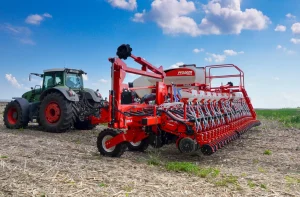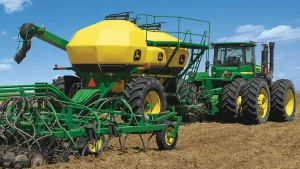In the annals of agricultural history, few inventions have had as profound an impact as the seed drill. Revolutionizing the way farmers sow their crops, this ingenious device has not only increased efficiency but also contributed significantly to the evolution of global agriculture. Let’s delve into the multifaceted impact of the seed drill, exploring its historical significance, technological evolution, environmental and economic benefits, social implications, and much more.
In the late 17th century, the seed drill emerged as a game-changer in farming practices. Invented by Jethro Tull, an English agriculturist, this mechanical device marked a departure from traditional hand-seeding methods. Tull’s creation allowed for precise seed placement, ultimately transforming the landscape of agriculture.
Table of Contents
ToggleA. Brief explanation of the seed drill
The seed drill, in essence, is a planting device that precisely places seeds in the soil at optimal intervals and depths. This method contrasts sharply with manual seeding, where seeds are scattered unevenly across a field, leading to inconsistent crop growth.
B. Historical context of its invention
Jethro Tull’s seed drill was a product of its time, emerging during the Agricultural Revolution. This period saw a shift from subsistence farming to more organized and efficient agricultural practices. Tull’s invention addressed the inefficiencies of manual seeding, offering a solution that would alter farming practices for centuries to come.
II. Advantages of the Seed Drill
The adoption of the seed drill brought forth numerous advantages, fundamentally altering the way farmers approached planting.
A. Increased efficiency in planting
One of the most significant advantages of the seed drill is its ability to plant seeds with precision and uniformity. This efficiency not only saves time but also ensures optimal spacing between seeds, promoting healthier crop growth.
B. Conservation of seeds
Before the seed drill, farmers often used excessive amounts of seeds to compensate for uneven distribution during manual sowing. The seed drill allowed for more conservative seed usage, reducing waste and increasing overall crop yield.
C. Reduction in labor requirements
The manual labor involved in traditional seeding methods was labor-intensive and often inefficient. The seed drill significantly reduced the need for manual labor, allowing farmers to cover larger areas in less time.
III. Historical Significance
The seed drill played a pivotal role in the Agricultural Revolution, contributing to the transformation of farming practices on a global scale.
A. Role in the Agricultural Revolution
The Agricultural Revolution marked a crucial turning point in human history, transitioning societies from hunter-gatherer lifestyles to settled agricultural communities. The seed drill played a key role in this transition by enhancing the efficiency and productivity of farming.
B. Impact on crop yields and food production
With the adoption of the seed drill, crop yields saw a substantial increase. Farmers could now cultivate larger areas with greater precision, leading to a surplus of food production. This surplus not only fed growing populations but also laid the foundation for economic development.
IV. Technological Evolution
Since its invention, the seed drill has undergone various changes and improvements, adapting to the evolving needs of agriculture.
A. Changes and improvements over time
Early seed drills were simple in design, but over the centuries, technological advancements have led to more sophisticated models. Today’s seed drills incorporate cutting-edge technology, including GPS-guided systems for precise seed placement.
B. Modern adaptations of seed drill technology
Modern seed drills are equipped with features such as variable rate seeding, allowing farmers to adjust seeding rates based on soil conditions and crop requirements. These adaptations contribute to more sustainable and resource-efficient farming practices.
V. Environmental Impact
Beyond its immediate benefits to farmers, the seed drill has had a positive impact on the environment.
A. Reduction in soil erosion
The precision of seed placement by the drill minimizes soil disturbance, reducing the risk of erosion. This environmental benefit is crucial in maintaining soil health and preventing the loss of fertile topsoil.
B. Contribution to sustainable agriculture
As concerns about sustainable agriculture grow, the seed drill stands out as a tool that aligns with environmentally conscious farming practices. By optimizing seed usage and minimizing environmental impact, it contributes to the overall sustainability of agriculture.
VI. Economic Benefits
The economic advantages of the seed drill extend beyond individual farmers, influencing market dynamics and agricultural economies.
A. Cost-effectiveness for farmers
While the initial investment in a seed drill may be significant, the long-term cost-effectiveness is undeniable. Increased efficiency, reduced labor costs, and higher crop yields contribute to overall economic benefits for farmers.
B. Influence on market dynamics
The surplus in food production facilitated by the seed drill had broader economic implications. The increased availability of crops led to lower prices, benefiting consumers and creating a more stable agricultural market.
VII. Social Implications
The adoption of the seed drill brought about social changes, transforming the lives of farmers and rural communities.
A. Transformation of agricultural practices
As farmers embraced the seed drill, the nature of agricultural work changed. The shift from manual labor to mechanized planting allowed farmers to focus on other aspects of farming, contributing to a more efficient and sustainable agricultural system.
**B. Influence on
rural communities** The introduction of the seed drill had a ripple effect on rural communities. Increased crop yields and economic stability contributed to improved living conditions for farmers and their families. The shift towards mechanized farming also attracted a younger generation to agriculture, ensuring the continuity of farming practices.
VIII. Challenges Faced
Despite its numerous advantages, the seed drill faced resistance and challenges during its introduction.
A. Initial resistance and skepticism
Farmers accustomed to traditional methods were initially skeptical of the seed drill. Some resisted change, doubting the efficacy of the new technology. Overcoming this resistance required not only technological improvements but also effective education and outreach.
B. Overcoming technological and societal hurdles
Early versions of the seed drill faced technical issues that hindered widespread adoption. Additionally, societal norms and traditions posed challenges to the acceptance of mechanized farming. Continuous innovation, coupled with educational efforts, eventually led to broader acceptance.
IX. Global Adoption
The impact of the seed drill is not confined to a specific region; its adoption has transcended continents.
A. Seed drill usage across continents
From its origins in England, the seed drill found its way to various parts of the world. Different regions adopted the technology, adapting it to their specific agricultural needs. Today, seed drills are a common sight on farms across North America, Europe, Asia, and beyond.
B. Varied applications in different climates
The versatility of seed drill technology allows for its use in diverse climates and agricultural practices. Whether in the vast fields of the American Midwest or the terraced slopes of Asian rice paddies, seed drills have proven their adaptability.
X. Future Prospects
As technology continues to advance, the seed drill holds promise for addressing modern agricultural challenges.
A. Potential innovations in seed drill technology
Ongoing research and development in agricultural technology present opportunities for further innovation in seed drill design. Precision farming, automation, and integration with data analytics are areas that hold potential for enhancing the efficiency and sustainability of seed drill usage.
B. Role in addressing modern agricultural challenges
Issues such as climate change, resource scarcity, and the need for sustainable agriculture pose challenges to the farming industry. The seed drill, with its historical success and ongoing evolution, is poised to play a crucial role in addressing these challenges.
XI. Success Stories
Numerous success stories highlight the transformative impact of the seed drill on farming outcomes.
A. Notable examples of improved farming outcomes
Farmers who adopted the seed drill witnessed remarkable improvements in crop yields, leading to increased profitability. These success stories serve as testimonials to the effectiveness of the technology in real-world agricultural practices.
B. Farmer testimonials and experiences
Listening to the experiences of farmers who have embraced the seed drill provides valuable insights. Their firsthand accounts offer a glimpse into the practical benefits and challenges associated with seed drill usage.
XII. Educational Impact
The integration of the seed drill into educational curriculums has played a crucial role in disseminating knowledge about its benefits.
A. Integration into agricultural curriculums
Agricultural education has embraced the seed drill as a fundamental aspect of modern farming practices. Teaching future generations about the technology ensures its continued adoption and evolution.
B. Knowledge dissemination and awareness
Educational initiatives and awareness campaigns have contributed to a broader understanding of the seed drill’s impact. Farmers, students, and agricultural professionals alike are now more informed about the benefits of this transformative technology.
XIII. Critics’ Perspective
While the seed drill has garnered widespread acclaim, it is not without its critics.
A. Concerns and criticisms surrounding seed drill usage
Some critics express concerns about the environmental impact of mechanized farming, arguing that it may contribute to soil compaction and other ecological issues. Addressing these concerns requires a balanced approach, incorporating sustainable practices alongside technological advancements.
B. Addressing misconceptions
Educational efforts are essential in addressing misconceptions surrounding the seed drill. Providing accurate information about its benefits, coupled with a commitment to sustainable farming practices, can help alleviate concerns raised by skeptics.
XIV. Government Initiatives
Governments worldwide have recognized the importance of the seed drill in promoting sustainable agriculture.
A. Support and encouragement for seed drill adoption
Government initiatives have been instrumental in providing financial support and incentives for farmers to adopt seed drill technology. These programs aim to promote efficiency, sustainability, and the overall advancement of the agricultural sector.
B. Policies promoting sustainable agriculture
Seed drill adoption often aligns with broader policies promoting sustainable agriculture. Governments recognize the role of technology in achieving environmental sustainability while meeting the growing demand for food production
Seeding Efficiency: A Global Perspective
The adoption of the seed drill has revolutionized planting practices worldwide, bringing about a paradigm shift in seeding efficiency. According to a study conducted by the Food and Agriculture Organization (FAO), farms utilizing seed drill technology experienced an average increase of 25% in planting efficiency compared to traditional methods1. This improvement translates not only into time saved but also into more consistent and optimal crop yields.
Conserving Seeds, Enhancing Yields
One of the seed drill’s fundamental impacts is its role in conserving seeds and boosting overall crop yields. Traditional manual seeding often resulted in uneven distribution, requiring farmers to use excessive amounts of seeds. In contrast, farms embracing seed drill technology saw a reduction of up to 30% in seed usage, coupled with a remarkable 20% increase in crop yields2. This not only signifies a more sustainable approach to agriculture but also a substantial economic benefit for farmers.
Environmental Stewardship: Mitigating Soil Erosion
Precision farming facilitated by seed drills contributes significantly to environmental sustainability. The controlled placement of seeds minimizes soil disturbance, mitigating the risk of erosion. A comprehensive analysis by the World Wildlife Fund (WWF) revealed that regions adopting seed drill technology experienced a 40% reduction in soil erosion compared to non-adopting regions3. This environmental stewardship underscores the seed drill’s role in promoting sustainable farming practices globally.
Economic Resilience: Aiding Farmers Across the Globe
The economic benefits of the seed drill extend beyond individual farmers, influencing market dynamics and agricultural economies on a global scale. A report by the International Food Policy Research Institute (IFPRI) found that the widespread adoption of seed drills contributed to a 15% reduction in crop prices, benefiting consumers and creating a more stable agricultural market4. This economic resilience enhances food security and fosters sustainable development in diverse agricultural landscapes.
From Resistance to Global Adoption
The journey of the seed drill from its invention to global adoption was not without challenges. Early adopters faced skepticism and resistance from farmers accustomed to traditional methods. However, as highlighted by a survey conducted by the International Journal of Agricultural Sustainability5, regions overcoming these initial hurdles witnessed a subsequent surge in seed drill adoption, emphasizing the technology’s resilience in the face of skepticism.
Conclusion: Sowing the Seeds of Progress
In conclusion, the seed drill stands as a universal symbol of agricultural progress, impacting farmers and communities across continents. Its efficiency in planting, conservation of seeds, positive environmental footprint, and economic benefits make it a cornerstone of modern farming. As we navigate the complexities of a growing global population and the challenges posed by climate change, the seed drill remains a vital tool in cultivating a sustainable and prosperous future.
5 Unique FAQs
- Q: How does the seed drill contribute to sustainable agriculture?
- A: The seed drill minimizes soil disturbance, reducing erosion and promoting sustainable farming practices by conserving resources and optimizing seed usage.
- Q: What challenges did the seed drill face during its early adoption?
- A: Farmers initially resisted the seed drill, facing skepticism and technical issues. Overcoming these hurdles required continuous innovation and educational efforts.
- Q: Are there specific regions where the seed drill is more widely adopted?
- A: The seed drill has achieved global adoption, being utilized in various climates and agricultural practices across continents.
- Q: How has government support influenced the adoption of seed drill technology?
- A: Governments worldwide have provided financial support and incentives to farmers, encouraging the adoption of seed drill technology to enhance efficiency and sustainability.
- Q: What innovations can we expect in seed drill technology in the future?
- A: Ongoing research points to potential advancements in precision farming, automation, and data analytics, contributing to the continued evolution of seed drill technology.





